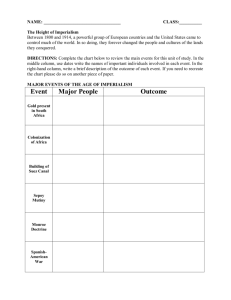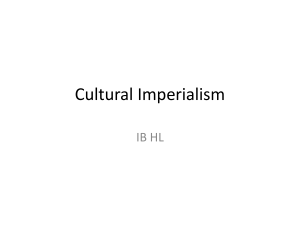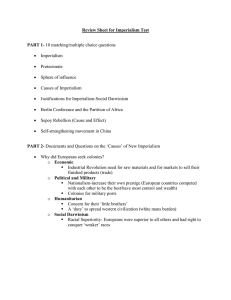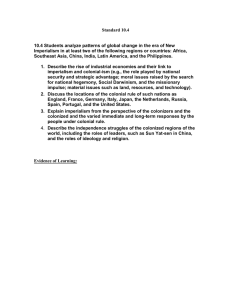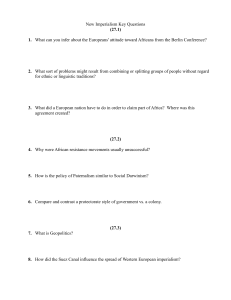IMPERIALISM AP European History Chapter 26
advertisement
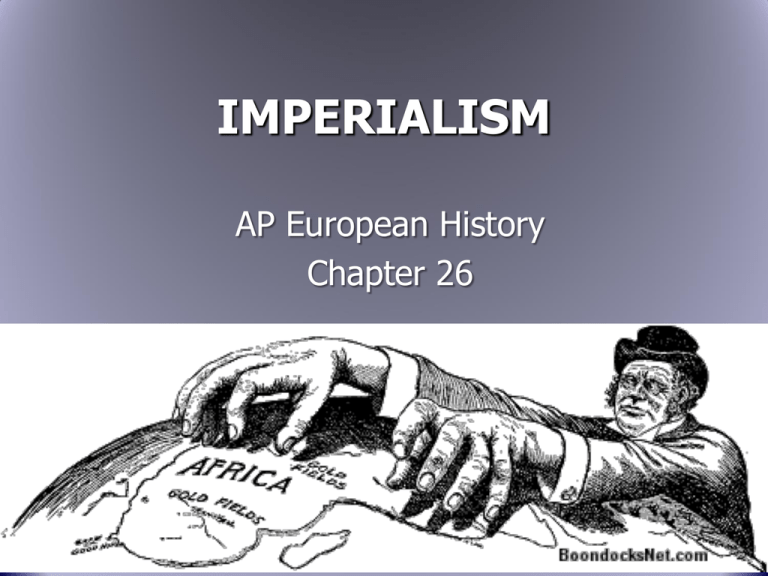
IMPERIALISM AP European History Chapter 26 I. The World Economy A. “Old Imperialism” (1816-1880) 1. economic not political B. Rise in global inequality 1. 1750 – average standard of living 2. Industrial Revolution opened the gap developed v. non-developed 3. Third World – stagnated income C. World Market 1. Great Britain & Industrial Revolution 2. Transportation Revolution 3. Growth of trade and conquest of distance encouraged Europeans to make foreign investments. D. European Migration 1. Population growth 2. 1815 to 1932 – 60 million left Europe. 3. Migration provided further impetus for Western expansion. 4. Characteristics of European Immigrants a. small peasant landowner or village craftsmen b. typically returned to homeland 1) Swallows 5. Asian Migrants a. indentured laborers who worked on plantations and mines b. “Great White Walls” – discriminatory laws designed to keep Asians out II. “New Imperialism” (1880-1914) A. formal political control B. Causes of New Imperialism: 1. Industrialism = Search for markets and raw materials 2. National Security = military power a. naval bases 3. International prestige = colonies were essential to great nations a. Heinrich von Treitschke 4. Social Darwinism & harsh racial doctrines 5. Technological & military superiority: a. machine gun b. quinine – prevented malaria c. steamship & telegraph 6. Jingoism – extreme patriotism in the form of aggressive foreign policy (propaganda) 7. Special-interest groups: missionaries C. Imperialism in Africa 1. Egypt a. Muhammad Ali (r. 1800-1849) 1) Reform & modernization b. Ismail (Khedive, 1863-1879) 1) Suez Canal (1869) 2) massive debt c. Tewfiq (r. 1879-1892) 1) Bankruptcy & Insurrection d. British protectorate 1882-1956 D. The Scramble for Africa 1. 1880, Euro nations controlled only 10% 2. Between 1880 and 1900 Britain, France, Germany, and Italy scrambled to carve up Africa. a. Ethiopia and Liberia remained independent. b. New Imperialism based on British model in Egypt – protectorate 1) military force, political domination, and a self-justifying ideology of beneficial reform North Africa in 1880 South Africa, 1880 E. South Africa 1. Cape Town – Dutch Afrikaners a. Great Trek b. Boer War (1899-1902): Jingoism 1) Cecil Rhodes – Rhodesia 2) Transvaal gold mines 3) Kruger Telegram b. Union of South Africa, 1910 F. Belgian Congo 1. King Leopold II of Belgium a. Central Africa b. Henry M. Stanley explored Congo Basin & established trading stations 2. Triggered “African Fever” G. Berlin Conference (1884-85) 1. International conference to establish basic rules for African Imperialism a. Jules Ferry & Bismarck b. “effective occupation” 2. Germany becomes imperial power a. protectorates in 1884-85 H. British objective 1. connect Southern & Northern colonies a. Cairo to Cape Town Cecil Rhodes, depicted in a Punch cartoon reflects the attitude of British imperialism American cartoon German cartoon French cartoon 2. Sudan a. Khartoum (1885) – Muslim massacre of British force b. Gen. Horatio Kitchener Battle of Omdurman (1898) (11,000 to 28) 3. Fashoda incident (1898) a. Diplomatic crisis 1) French & British standoff 2) Dreyfus Affair Imperialism in Africa, 1914 III. The “New Imperialism” Ideology D. European Ideology 1. Nationalism 2. Social Darwinism 3. “White man’s burden” Rudyard Kipling 4. Protect and improve lives of nonWesterners The White Man’s Burden Take up the White Man's burden-Send forth the best ye breed-Go, bind your sons to exile To serve your captives' need; To wait, in heavy harness, On fluttered folk and wild-Your new-caught sullen peoples, Half devil and half child. D. Critics of imperialism 1. J. A. Hobson – Imperialism the quest for empire diverted popular attention away from domestic reform 2. Joseph Conrad – Heart of Darkness the main character, once a liberal scholar, turns into a savage brute Henry Labouchere – mocking Kipling Pile on the Brown Man’s burden! And if ye rouse his hate, Meet his old-fashioned reasons With Maxims up to date, With shells and Dum-Dum bullets A hundred times plain The Brown Man’s loss must never Imply the White Man’s gain. IV. New Imperialism in Asia A. Responses to Western imperialism 1. China – Qing Dynasty a. refused diplomatic relations with Western governments 2. Opium Wars (1839-1842) a. Treaty of Nanking, 1842 1) Hong Kong, $100 million, 4 cities open for trade 3. 2nd Opium War (1856-1860) a. Tai Ping Rebellion (1850-1864) 1) Civil War in southern China (20 million killed) b. British & French soldiers occupied Beijing 1) further opened China to foreign trade 4. Hundred days of reform (1898) a. Chinese response to foreign occupation b. Boxer Rebellion, 1900 5. Open Door Policy “American Diplomacy”, 1900 B. India – Great Britain 1. Mogul Empire – Hindu & Muslim 2. “Crown Jewel” 2. British East India Company, Robert Clive 3. The Great Rebellion Sepoy mutiny (1857-58) The mutiny began in Meerut, and soon the angry Sepoys moved on to Delhi. The massacre at Cawnpore, now Kanpur, became a rallying cry for outraged Britons. Sepoy Mutiny 4. British women in India a. managed plantation household 5. High-caste Hindus a. British educated b. Indian elite 1) Irrigation projects 2) Railroads c. Hindu Indian National Congress (1885) C. Japan: Commodore Mathew Perry (1853) 1. Japanese isolationism – preserve culture a. feudal society: emperor, shogun, samurai 2. Meiji Restoration (1867) a. patriotic samurai seized government & restored emperor b. goal: meet foreign threat 1) modernization 2) dual revolution c. Japanese imperialism: Sino-Japanese War (1894-1895) 3. Russo-Japanese War (1904) a. Japanese naval victory b. Treaty of Portsmouth
